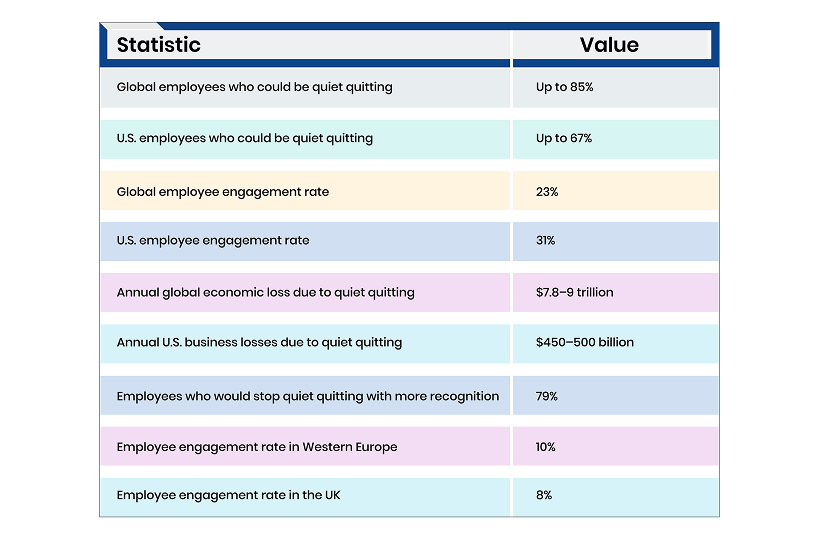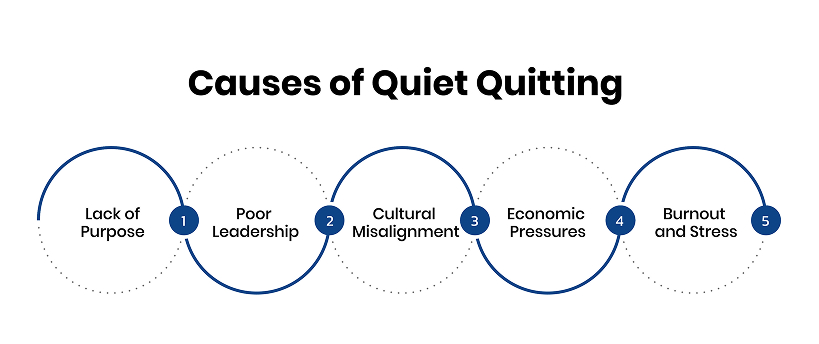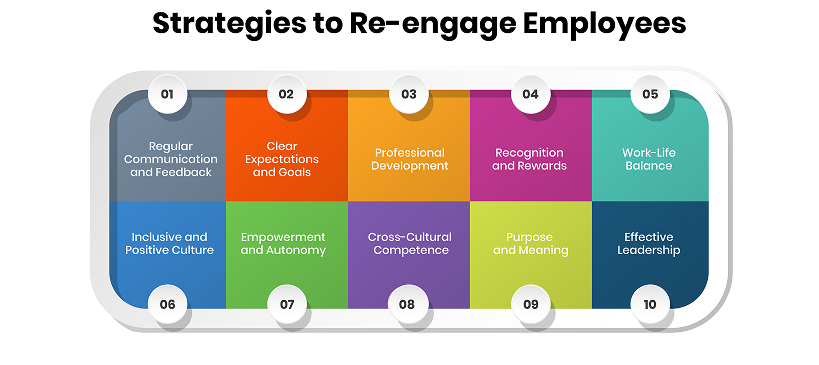
The “quit and stay risk,” known as “quiet quitting,” describes employees who remain at their positions but are psychologically checked out, which causes them to do just what their jobs require. According to Gallup, the worldwide economy loses approximately $9 trillion annually because disengaged employees create a significant challenge.
This article explores talent enablement strategies that help maintain employee commitment while enhancing workplace collaboration within different economic demographics and cultural settings. It includes statistics, trends, facts, and specific approaches organizations should follow to address this problem successfully.
The widespread issue of quiet quitting manifests itself as an economic concern. Below are statistics that highlight its prevalence and impact:

Employee disengagement is a critical organizational and well-being problem, as disengaged workers create significant performance repercussions and job satisfaction challenges. The research by Gallup reveals that worldwide, only 15% of employees show active engagement, which means 85% might either be disengaged or act as active disengagers. Even in the United States, where engagement numbers stand at 33%, this figure shows that quiet quitting affects many employees.
The development of effective strategies requires the identification of the underlying causes of quiet quitting. Common reasons include:

To reverse the quit and stay risk, organizations and businesses can implement research-backed strategies:

1. Regular Communication and Feedback
Employee engagement thrives on regular contact between managers and employees, building mutual trust and openness. Workplace engagement develops through weekly individual conferences that allow staff members to share problems, get helpful comments, and gain a sense of value.
The short-time meetings of 15-30 minutes aim to solve problems at the beginning, which avoids employee disengagement. According to Gallup’s research, employees who regularly meet with their supervisors become three times more engaged because regular conversations help create motivated teams.
2. Clear Expectations and Goals
When organizations establish precise expectations, they connect workers to company goals, which creates employee purpose and direction.
Managers must establish concrete performance indicators that measure success while properly explaining team members’ mission-level contributions during ongoing team communication sessions. When expectations become clear, employees receive proper direction to exceed their minimum performance.
Clarifying personal work effects leads employees to outperform their targets by 22%, so organizations should utilize this method for employee engagement.
3. Professional Development
Employees stay motivated through professional development, as such initiatives let them grow in their careers. The combination of virtual learning opportunities, mentorship help, and structured growth plans through organizations maintains employee engagement throughout career development.
When workers feel stagnant, they are more likely to quit quitely, making this solution beneficial to this problem. Direct investment in career development by businesses leads employees to remain in their roles longer, according to LinkedIn data, which shows that 94% of employees choose such organizations.
4. Recognition and Rewards
The development of recognition practices within organizations creates stronger employee morale and increased engagement. Employee recognition becomes stronger through implementing peer-to-peer recognition programs that provide performance awards and maintain fair compensation systems.
Employees have shown that 79% would stop quiet quitting when organizations provide acknowledgment of their work performance. Integrating workplace recognition systems produces a supportive corporate culture that spurs prolonged dedication from employees.
5. Work-Life Balance
Organizations need to support work-life balance practices to stop burnout development and enhance staff engagement. The combination of flexible working arrangements, including hybrid schedules and wellness support systems, which include mental health care, helps employees handle their stress levels effectively. Employee programs that demonstrate a commitment to their welfare help staff stay dedicated. Mental health services and flexible work arrangements are essential for modern organizations, as 81% of employees value these benefits.
6. Inclusive and Positive Culture
Businesses should develop an inclusive working environment that appreciates employee diversity because it strengthens employee interaction and employee involvement. Organizations must implement employee resource groups (ERGs) and team-building activities to build staff connections.
This approach counters feelings of disconnection, particularly in diverse teams. Data shows that a workplace that actively includes all members functions at 74% higher productivity levels because staff members feel treated with respect and engaged in making full contributions.
7. Empowerment and Autonomy
Granting employees autonomy in their roles fosters a sense of ownership and responsibility. When employees keep control of their work matters, they develop innovation and show increased engagement. Employees achieve empowerment when their managers let them participate in goal formulation and enable personal task execution methods. Job happiness increases by 12% when employees receive autonomy because they recognize their value and appreciate the trust shown, which decreases their likelihood of disengagement.
8. Cross-Cultural Competence
International team employees must master cultural sensitivity to achieve effective engagement. Managers benefit from cross-cultural training since it enables them to modify their communication approaches for high-context (implicit) and low-context (explicit) cultures to ensure employees experience respect.
The population of Japan prioritizes indirect communication because they practice high-context approaches, yet high-context methods do not fit the U.S. since its population follows low-context standards. This competence creates better teamwork since culturally aware teams exhibit 57% higher employee engagement.
9. Purpose and Meaning
Connecting employees’ work to the organization’s mission instills a sense of purpose. Company managers should declare which team achievements support organizational targets and establish recognition procedures for work aligned with the mission. This approach counters the lack of motivation, a key driver of quiet quitting. The data shows that employees with meaningful jobs demonstrate four times higher levels of engagement, thus making purpose effectiveness key in the re-engagement process.
10. Effective Leadership
The engagement of employees heavily depends on robust leadership because leaders are responsible for 70% of team engagement variations. Leaders who receive empathy training alongside support and coaching development will motivate their teams better. Educational leadership development programs offer essential training to managers, which leads to their development of these skills and subsequently creates a supportive work atmosphere. When employees are engaged, the trust levels between workers and their managers tend to increase by 96%.
The approach needs careful thought when engaging employees across different economic and cultural contexts. Employees interpret engagement initiatives heavily depending on their cultural background, according to Hofstede's defined cultural dimensions. For example:
Organizational success in multicultural work groups improves when employees undergo cultural training and cultural intelligence (CQ) development at the employee and supervisor levels.
Multiple trends affect employee engagement across future workplaces. These trends are:
A Gallup Q12 survey provides 12 components for organization engagement assessment, including clear expectations and recognition. Using this survey as a foundation helps lead discussions and enables assessment activities and performance target development. Employee engagement technology, like CultureMonkey, provides real-time feedback, anonymous survey capabilities, and performance analysis tools for tracking progress.
Reversing the quit and stay risk needs multi-faceted efforts, which identify original disengagement causes as organizations adapt their strategies to various cultural environments and economic situations.
The workplace re-engagement of employees happens when organizations prioritize open dialogue and define goals, provide development prospects and acknowledge team members’ achievements, balance work demands with personal needs and support diverse backgrounds, empower workforce members, teach cross-cultural sensitivity, connect employees to organizational purpose, and train leaders effectively.
The strategies and statistics demonstrating quiet quitting’s high occurrence and associated costs provide essential tools for developing productivity and alignment in current global workplaces.
Hlib Yatsenko is the Editor-in-Chief at Made for Lives. He is passionate about writing in-depth articles on various topics for different online platforms and sharing his knowledge and experience.

CredBadge™ is a proprietary, secure, digital badging platform that provides for seamless authentication and verification of credentials across digital media worldwide.
CredBadge™ powered credentials ensure that professionals can showcase and verify their qualifications and credentials across all digital platforms, and at any time, across the planet.

Please enter the License Number/Unique Credential Code of the certificant. Results will be displayed if the person holds an active credential from TMI.